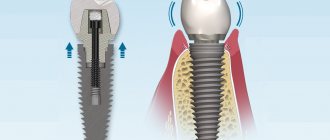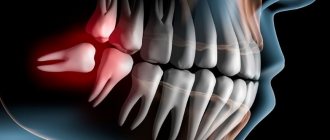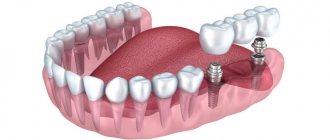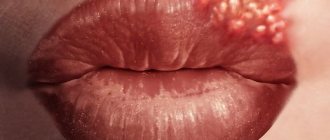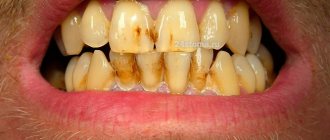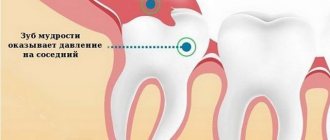Many patients ask dentists: should teeth be a little loose or does this indicate some kind of disease? Some mobility of dental units is observed normally, but it is very small and usually not noticeable. If a person’s teeth are noticeably loose and we are not talking about milk teeth, which should soon be replaced, it is necessary to find the cause of their mobility and eliminate it. Why do teeth become loose in adults, how to treat this pathology and what should be done in this case?
Symptoms
In the vast majority of cases, teeth become loose due to advanced caries and the presence of tartar. Clear signs that you will experience periodontal problems in the coming months:
- dark spots on tooth enamel;
- bleeding gums;
- high sensitivity of teeth to cold/hot;
- pain when chewing.
At the initial stage, the amplitude of tooth loosening does not exceed 1 mm. Subsequently, it increases, and the tooth wobbles in all directions. Biting or chewing with it is uncomfortable or even impossible.
Periodontal diseases are most often accompanied by atrophy of the jaw bone. That is, the volume of bone tissue in which the teeth are anchored gradually decreases. This is clearly noticeable by the “sagging” of the gum line, the formation of gum pockets and the increasing exposure of the necks of the teeth. If no measures are taken, bone volume can decrease catastrophically, leading to loose teeth. And this already threatens their loss.
Reasons for crown mobility
In most cases, the mobility of the prosthesis has nothing to do with the qualifications of the implantologist. Among the main reasons are:
- Loosening of the screw connection between the abutment and the prosthesis
. This is possible if products from different brands were used. For example, the implant is Nobel Biocare, and the superstructure is Osstem. It is important to use original products of the same brand, which are developed as a whole, otherwise the likelihood of failure of all components is too high. - Loss of properties of the cement composition
. As a rule, this occurs due to high chewing load on the tooth, adherence to too hot or cold foods. The prosthetic system is fixed to the abutment with a soft cement composition; under unfavorable conditions, it begins to collapse, is gradually washed out, and the crown becomes loose.
The crown can be reattached in the clinic where the implantation was performed. The orthopedist will tighten the screw with an implantation key and secure the prosthesis. With the cement method of fastening, the crown will be cleaned of the remnants of the old composition and “set” on the cement again. Things are different if not only the crown, but the implant along with it is loose. It is very difficult to independently determine whether the implant crown is loose or the fixation of the intraosseous element is weakened. This requires a medical assessment of the clinical picture and a diagnostic examination.
Teeth started to loosen: what to do?
The sooner you go to the dentist, the greater the chance of saving the tooth. The doctor will suggest taking a targeted or panoramic X-ray, depending on how many teeth are loose. They can be used to determine the degree of periodontal damage and bone loss.
Before starting treatment, it is necessary to carry out professional oral hygiene - clean the teeth (including under the gums) from hard deposits (tartar) and bacterial plaque. This is a standard procedure performed with an ultrasound machine. Ideally, such cleaning should be carried out once every six months.
If necessary, the patient also undergoes systemic diagnostics and consults with specialized doctors. Further treatment depends on how loose the teeth are and what the causes of the loosening are.
Implant mobility due to patient negligence
The main reason why the intraosseous structural element began to wobble is ignoring the recommendations regarding the care of implants and the orthopedic system fixed to them. If the surgeon performed the implantation without violating the protocol, 90% of the responsibility for rehabilitation lies with the patient. The following can lead to loosening of the structure:
- Refusal of medications prescribed by the surgeon for the speedy restoration of injured tissue, prevention of the inflammatory process, etc.
- Regular consumption of alcohol and smoking slow down the rate of engraftment of the artificial root, increases the risk of peri-implantitis, and impairs blood circulation in the tissues. Clinical studies have shown that implant failure in patients with bad habits is 3 times higher than in those who do not have them.
- Overload of the artificial root when chewing hard foods. Premature chewing load on the implant. Typically, the doctor recommends following a soft diet for 2-3 weeks after the intervention. Ignoring the recommendation leads to displacement of the implant in its bed, disruption of osseointegration and, as a consequence, rejection of the intraosseous element.
The survival rate of a titanium structure is also affected by systemic diseases accompanied by impaired regenerative processes. These include diabetes mellitus, immunodeficiency states, oncological processes, some pathologies of the central nervous system, and chronic processes in the oral cavity.
What will the doctor do if the tooth is loose?
In modern dentistry, tooth-preserving methods are practiced, so a tooth is removed only if it is very loose and cannot be restored. When an adult’s teeth become loose, treatment depends on the causes and course of the pathological process.
If the loosening is still minor and is caused by weakening of the gums, it is necessary to clean the periodontal pockets from bacterial deposits. For this purpose, therapy is carried out using the Vector device. The doctor directs a healing mixture into the pockets, which acts simultaneously with ultrasonic vibrations and effectively cleanses the teeth down to the roots. The procedure is painless and promotes gum healing. Also, many dentists use lasers for the same purposes.
After this, the doctor prescribes therapeutic treatment:
- applications with antiseptic drugs;
- applying medicinal gels to the gums that relieve inflammation and restore tissue;
- strengthening gums with rinses - herbal infusions (aloe, oak bark);
- taking vitamins;
- gum massage, which needs to be performed 3-4 times a day on your own;
- if there is inflammation with purulent discharge, the dentist will recommend antibiotics.
In severe cases of periodontitis, when the gum pockets are deep (more than 7 mm), surgical intervention may be necessary - open curettage. During this procedure, the surgeon opens the gum, clears the pocket of infection, applies medication, and sutures the tissue.
Useful products containing micro- and macroelements
Thanks to a well-formulated diet, teeth receive from food the elements necessary for aesthetics and health. To try to balance your diet yourself, it is important to understand which elements are most suitable for maintaining the basic functions of a person's teeth.
It is not at all necessary to eat only high-quality food purchased in expensive stores. It is enough to properly balance the diet so that the dental tissues receive everything they need.
The daily diet requires the presence of necessary vitamins, micro- and macroelements, without which dental health will be undermined. Experts advise following the daily norm, which will allow you to keep your teeth healthy and seek help from dentists less often.
Calcium
An element that everyone knows about. It is considered the main component of dental tissue. Lack of it in the diet leads to rapid tooth decay. The absence or insufficient amount of calcium in food leads to the destruction of enamel, a decrease in the resistance of teeth to various influences, and leads to the formation of caries and gum pathologies.
To get the necessary element, it is recommended to consume the following products:
- legumes (beans, beans);
- eggs;
- hard cheeses;
- almond;
- sesame;
- raisin;
- black bread;
- dairy products (cottage cheese, milk, cheese curd);
- White cabbage.
For adults, the daily norm is 800 g per day. Children and pregnant women need larger dosages. Their daily norm exceeds 1200–1800 g of calcium.
Phosphorus
This microelement is a connecting link with which it is possible to correctly distribute calcium particles obtained from food. Strengthens enamel and hard tooth tissues. Natural phosphorus is found in large quantities in potatoes, legumes, cheese, poultry, beef, fish, buckwheat, rice and eggs.
The daily intake of phosphorus for an adult is 1500–1800 g.
Fluorine
Foods that are good for teeth should include sea fish, pork, buckwheat, walnuts and poultry. They contain a large amount of natural fluoride, which protects teeth from negative external influences.
Lack of fluoride leads to the formation of caries and periodontal disease.
Every day a person should receive at least 7–10 g of fluoride from healthy foods. If this is not ensured, pathogenic microorganisms that enter with food, air and drink destroy our teeth.
Iron
An important element in the body's hematopoietic system is iron. It is obtained from peas, mushrooms, spinach, apples, walnuts, beef liver or seaweed. It ensures normal blood supply to the gums and nearby tissues around the tooth. A lack of iron quickly leads to gum damage - periodontal disease.
The daily dose of the element ranges from 10 to 18 g. In the absence of the element entering the body, pathologies develop in a short time and quickly affect the gums.
| Microelement | Products containing |
| Calcium | Milk, cottage cheese, eggshells, beans, beans, sesame seeds, almonds, white cabbage, black bread. |
| Phosphorus | Potatoes, legumes, cheese, poultry, eggs, beef, fish, buckwheat, rice. |
| Fluorine | Pork, walnuts, poultry, sea fish. |
| Iron | Peas, egg yolk, spinach, apples, walnuts, beef liver, mushrooms, seaweed. |
Knowing which foods contain useful microelements, you can create a competent diet to get everything you need for healthy teeth.
What to do if the tooth is very loose?
An effective method of strengthening teeth is splinting. It returns teeth to their functions and allows you to avoid extraction for a long time. Tires are most often made from safe fiberglass material; aramid threads, metal and ceramics can be used. The purpose of the procedure is to fasten the mobile teeth between themselves and the adjacent healthy teeth.
The splint is installed on the inside of the dentition by drilling shallow grooves in the teeth. Fiberglass tape or aramid cord is secured into these grooves with dental adhesive, and then they are filled and polished. Durable and aesthetic materials prevent teeth from loosening further, and therapeutic methods help strengthen periodontal and gum tissue. In many cases, it is possible to significantly reduce the degree of mobility.
Consumer Reviews
yuliya1305 (otzovik.com):
“Hello dear friends and readers of the site. Today I want to share with you a review about the Vitamin and Mineral Complex Coral Calcium Asepta
These vitamins contain:
- Coral calcium;
- Coenzyme G10$
- Vitamin C;
- Vitamin D3;
- Vitamins B3, B6;
- Vitamin A;
- Green tea extract.
These vitamins come in 721 mg tablets.
To prevent my gums from bleeding, I also use other drugs from this company. I have already written my reviews about them... By the way, these vitamins are contraindicated for pregnant women.
Well, I’ll tell you honestly, I’m very pleased with these drugs and recommend them to everyone. Because Vertex lives up to expectations!\3
Svettik19 (otzovik.com):
"Hi all!
A little background. Having had a sore throat, which I successfully cured myself at home without taking antibiotics, I was glad that everything worked out. But that was not the case.
Two weeks later, I realized that something was wrong with my gums. An unpleasant sensation appeared in the mouth. I noticed that my gums became more sensitive. Pain occurred when brushing teeth. I was very afraid that periodontitis would develop.
I immediately purchased several gum rinses, as well as the Asept vitamin and mineral complex, a domestic manufacturer. The course of administration is designed for 40 days, 1 tablet per day.
I felt an improvement after 2 weeks of regularly taking vitamins, and also lightly massaged my gums with tea tree essential oil.
At the moment I have completed the course and can already give a real review. The composition of the complex is very successful and is aimed specifically at strengthening the gums and maintaining healthy teeth.
Its composition is excellent:
coral calcium, coenzyme, vitamin C, vitamin D3, vitamins B3, B6, vitamin A. And also green tea extract.
All these components are in reasonable dosage. Can be taken without fear. The tablet itself is oval in shape and is very easy to swallow.
It took me a while to find this complex; I had to go around several pharmacies in the city and ordered a pharmacy online.
I can confidently recommend it, I liked how they work. I think they can also be taken as a preventative measure.”
Prevention
The best prevention of tooth mobility is good oral hygiene. To do this, the doctor will recommend special products and instruments: paste, balm, rinse, dental floss, irrigator. Regular (once every 6 months, and in case of gum problems - once every 3-4 months) visits to the dentist for professional teeth cleaning are required. You should also pay attention to proper nutrition, rich in calcium, vitamins and minerals.
Publisher: Expert magazine about dentistry Startsmile.ru
Author of the material: Igor Skripnik
Preventive measures
To reduce the risk of the crown loosening and falling out, it is important to strictly follow the specialist’s instructions after the procedure, as well as maintain cleanliness and hygiene of the oral cavity. Here's what prosthetics experts recommend in this regard:
- brush your teeth twice a day, rinse your mouth after every meal, use floss. It is advisable to purchase an irrigator - a device that supplies a powerful air-water jet for better cleaning of hard-to-reach places. You can read more about the principle of operation of the irrigator and popular models of the device in our special article,
- follow some nutritional principles. For example, immediately after the procedure you will have to give up products that are too hard and stretchy. Subsequently, it is better to forget about the habit of gnawing seeds with your teeth and cracking the shell,
- It is better to quit smoking and drinking alcohol too often,
- treat the installed structure carefully and carefully, regularly check it for chips, cracks and other damage,
- When the first alarming symptoms appear, you should immediately consult a doctor.
To maintain your smile, proper dental hygiene is important.
After dentures, do not forget to visit the dentist every six months for preventive examinations and a professional. hygiene. At each such appointment, the doctor will evaluate not only the condition of the teeth and gums, but also the integrity and functionality of the installed dentures. If necessary, when the product’s expiration date approaches, a specialist will prescribe its timely replacement.
1Massironi, D. Precision and aesthetics. Clinical and dental stages of dental prosthetics, 2008.
Gum massage
Regular gum massage will help improve blood flow in the jaw and avoid the development of inflammation in the future. You can do massage yourself, even if you are far from medicine.
- First, wash your hands thoroughly.
- Then move your thumb and index finger along the gums: using circular movements, you need to massage the gums from the central part to the sides.
- Massage your gums for 5 minutes.
- Repeat the procedure morning and evening.
It is recommended to end each massage session with a herbal rinse, for example, a decoction of chamomile or oak bark.
